Critical Analysis of Mathematics Teaching: Equivalent Fractions Lesson
VerifiedAdded on 2022/12/15
|8
|2520
|418
Report
AI Summary
This report provides a critical analysis of a mathematics lesson focused on teaching equivalent fractions to stage 3 students. The analysis examines the teacher's methods, strengths, and weaknesses, considering the NSW K-6 Mathematics Syllabus and relevant learning theories. The report highlights areas for improvement, such as incorporating prior knowledge and utilizing more interactive teaching strategies. An alternate lesson plan is proposed, emphasizing interactive methods like food-based activities and fraction tiles to enhance student engagement and understanding. The justification for the alternative approach is based on the goal of fostering deeper conceptual understanding and problem-solving skills, rather than just rote memorization. The report emphasizes the importance of considering individual student needs and integrating technology and real-world experiences into the learning process to make mathematics more enjoyable and accessible. The overall aim is to promote strategic thinking, fluency, and the ability to apply mathematical concepts effectively.
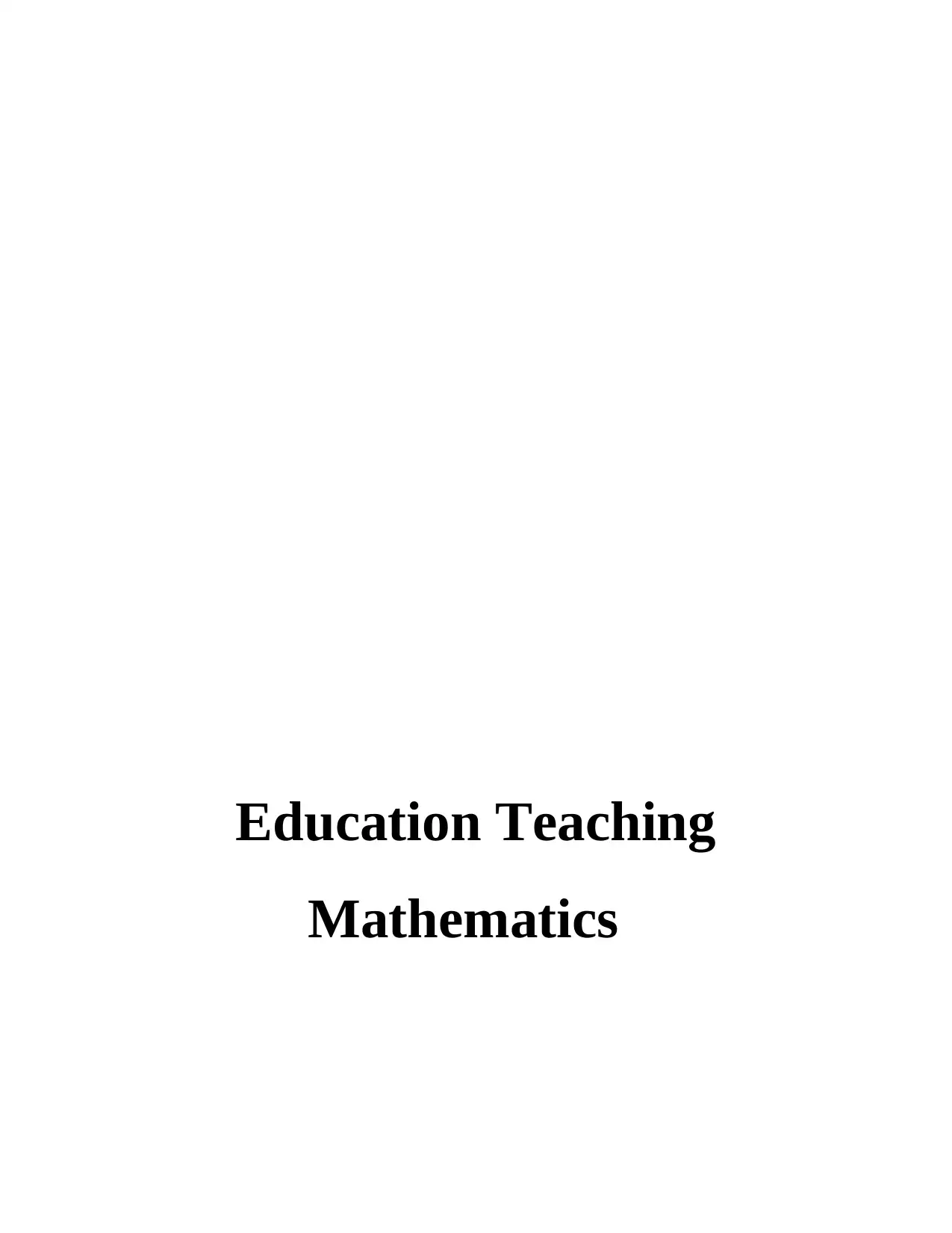
Education Teaching
Mathematics
Mathematics
Paraphrase This Document
Need a fresh take? Get an instant paraphrase of this document with our AI Paraphraser
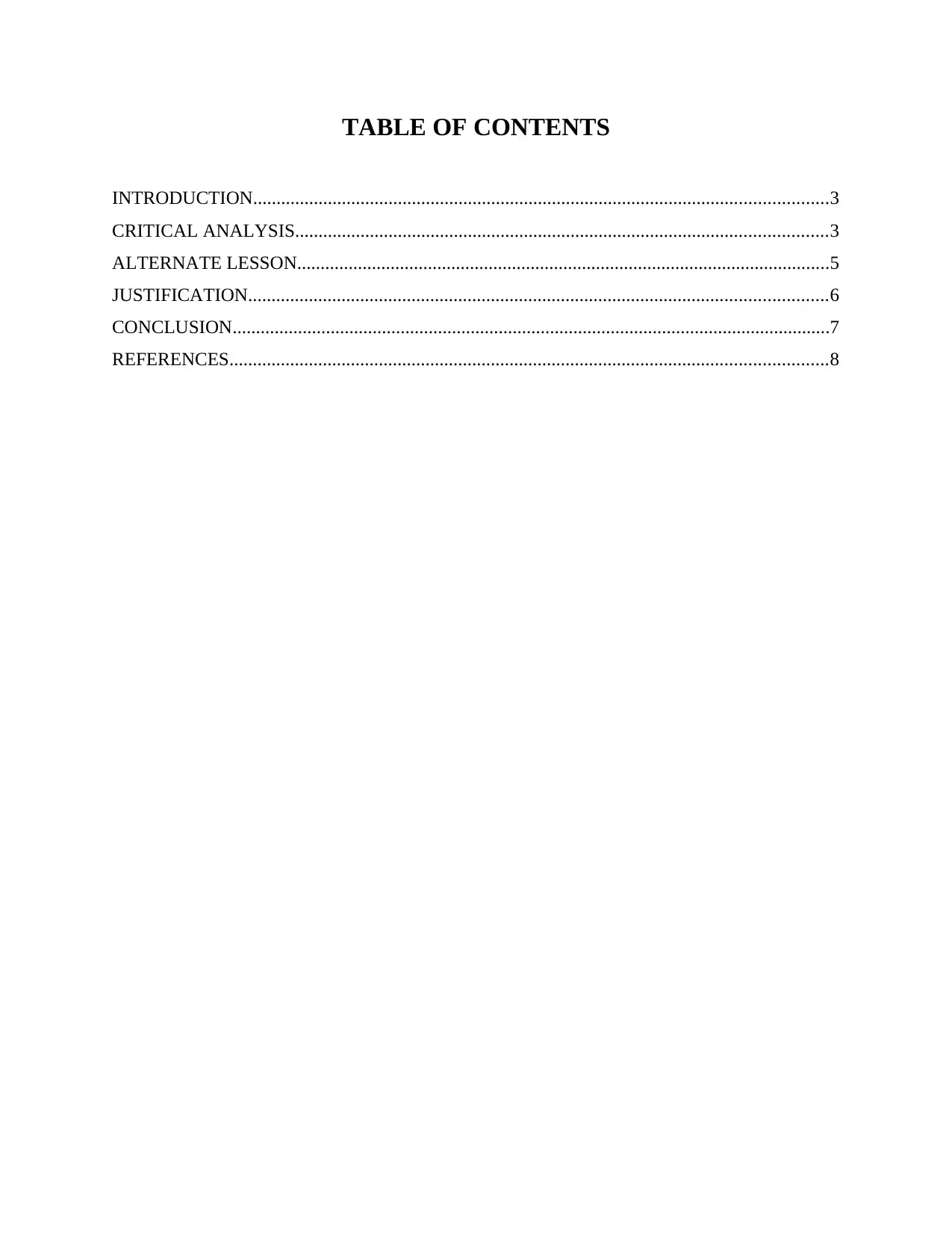
TABLE OF CONTENTS
INTRODUCTION...........................................................................................................................3
CRITICAL ANALYSIS..................................................................................................................3
ALTERNATE LESSON..................................................................................................................5
JUSTIFICATION............................................................................................................................6
CONCLUSION................................................................................................................................7
REFERENCES................................................................................................................................8
INTRODUCTION...........................................................................................................................3
CRITICAL ANALYSIS..................................................................................................................3
ALTERNATE LESSON..................................................................................................................5
JUSTIFICATION............................................................................................................................6
CONCLUSION................................................................................................................................7
REFERENCES................................................................................................................................8
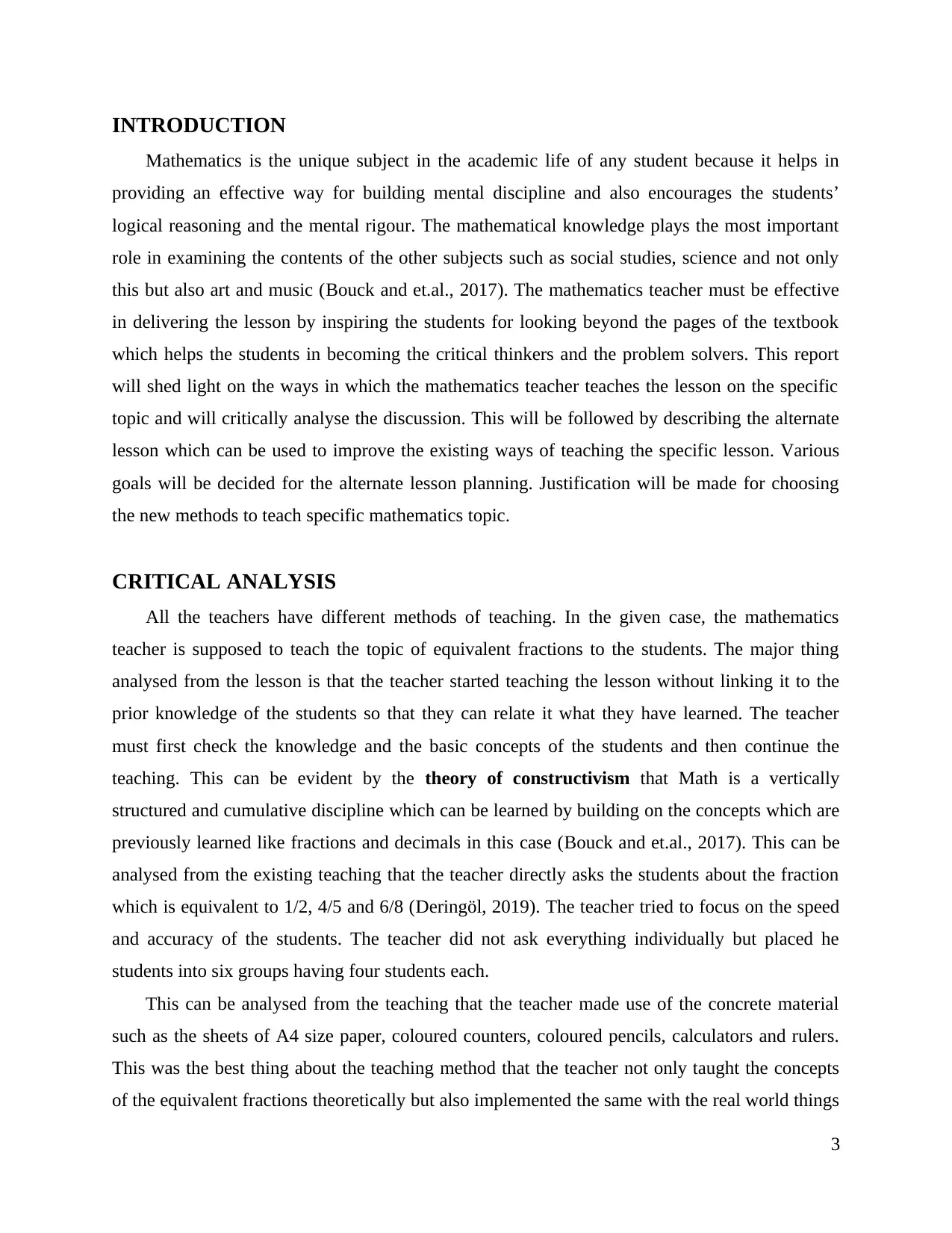
INTRODUCTION
Mathematics is the unique subject in the academic life of any student because it helps in
providing an effective way for building mental discipline and also encourages the students’
logical reasoning and the mental rigour. The mathematical knowledge plays the most important
role in examining the contents of the other subjects such as social studies, science and not only
this but also art and music (Bouck and et.al., 2017). The mathematics teacher must be effective
in delivering the lesson by inspiring the students for looking beyond the pages of the textbook
which helps the students in becoming the critical thinkers and the problem solvers. This report
will shed light on the ways in which the mathematics teacher teaches the lesson on the specific
topic and will critically analyse the discussion. This will be followed by describing the alternate
lesson which can be used to improve the existing ways of teaching the specific lesson. Various
goals will be decided for the alternate lesson planning. Justification will be made for choosing
the new methods to teach specific mathematics topic.
CRITICAL ANALYSIS
All the teachers have different methods of teaching. In the given case, the mathematics
teacher is supposed to teach the topic of equivalent fractions to the students. The major thing
analysed from the lesson is that the teacher started teaching the lesson without linking it to the
prior knowledge of the students so that they can relate it what they have learned. The teacher
must first check the knowledge and the basic concepts of the students and then continue the
teaching. This can be evident by the theory of constructivism that Math is a vertically
structured and cumulative discipline which can be learned by building on the concepts which are
previously learned like fractions and decimals in this case (Bouck and et.al., 2017). This can be
analysed from the existing teaching that the teacher directly asks the students about the fraction
which is equivalent to 1/2, 4/5 and 6/8 (Deringöl, 2019). The teacher tried to focus on the speed
and accuracy of the students. The teacher did not ask everything individually but placed he
students into six groups having four students each.
This can be analysed from the teaching that the teacher made use of the concrete material
such as the sheets of A4 size paper, coloured counters, coloured pencils, calculators and rulers.
This was the best thing about the teaching method that the teacher not only taught the concepts
of the equivalent fractions theoretically but also implemented the same with the real world things
3
Mathematics is the unique subject in the academic life of any student because it helps in
providing an effective way for building mental discipline and also encourages the students’
logical reasoning and the mental rigour. The mathematical knowledge plays the most important
role in examining the contents of the other subjects such as social studies, science and not only
this but also art and music (Bouck and et.al., 2017). The mathematics teacher must be effective
in delivering the lesson by inspiring the students for looking beyond the pages of the textbook
which helps the students in becoming the critical thinkers and the problem solvers. This report
will shed light on the ways in which the mathematics teacher teaches the lesson on the specific
topic and will critically analyse the discussion. This will be followed by describing the alternate
lesson which can be used to improve the existing ways of teaching the specific lesson. Various
goals will be decided for the alternate lesson planning. Justification will be made for choosing
the new methods to teach specific mathematics topic.
CRITICAL ANALYSIS
All the teachers have different methods of teaching. In the given case, the mathematics
teacher is supposed to teach the topic of equivalent fractions to the students. The major thing
analysed from the lesson is that the teacher started teaching the lesson without linking it to the
prior knowledge of the students so that they can relate it what they have learned. The teacher
must first check the knowledge and the basic concepts of the students and then continue the
teaching. This can be evident by the theory of constructivism that Math is a vertically
structured and cumulative discipline which can be learned by building on the concepts which are
previously learned like fractions and decimals in this case (Bouck and et.al., 2017). This can be
analysed from the existing teaching that the teacher directly asks the students about the fraction
which is equivalent to 1/2, 4/5 and 6/8 (Deringöl, 2019). The teacher tried to focus on the speed
and accuracy of the students. The teacher did not ask everything individually but placed he
students into six groups having four students each.
This can be analysed from the teaching that the teacher made use of the concrete material
such as the sheets of A4 size paper, coloured counters, coloured pencils, calculators and rulers.
This was the best thing about the teaching method that the teacher not only taught the concepts
of the equivalent fractions theoretically but also implemented the same with the real world things
3
⊘ This is a preview!⊘
Do you want full access?
Subscribe today to unlock all pages.

Trusted by 1+ million students worldwide
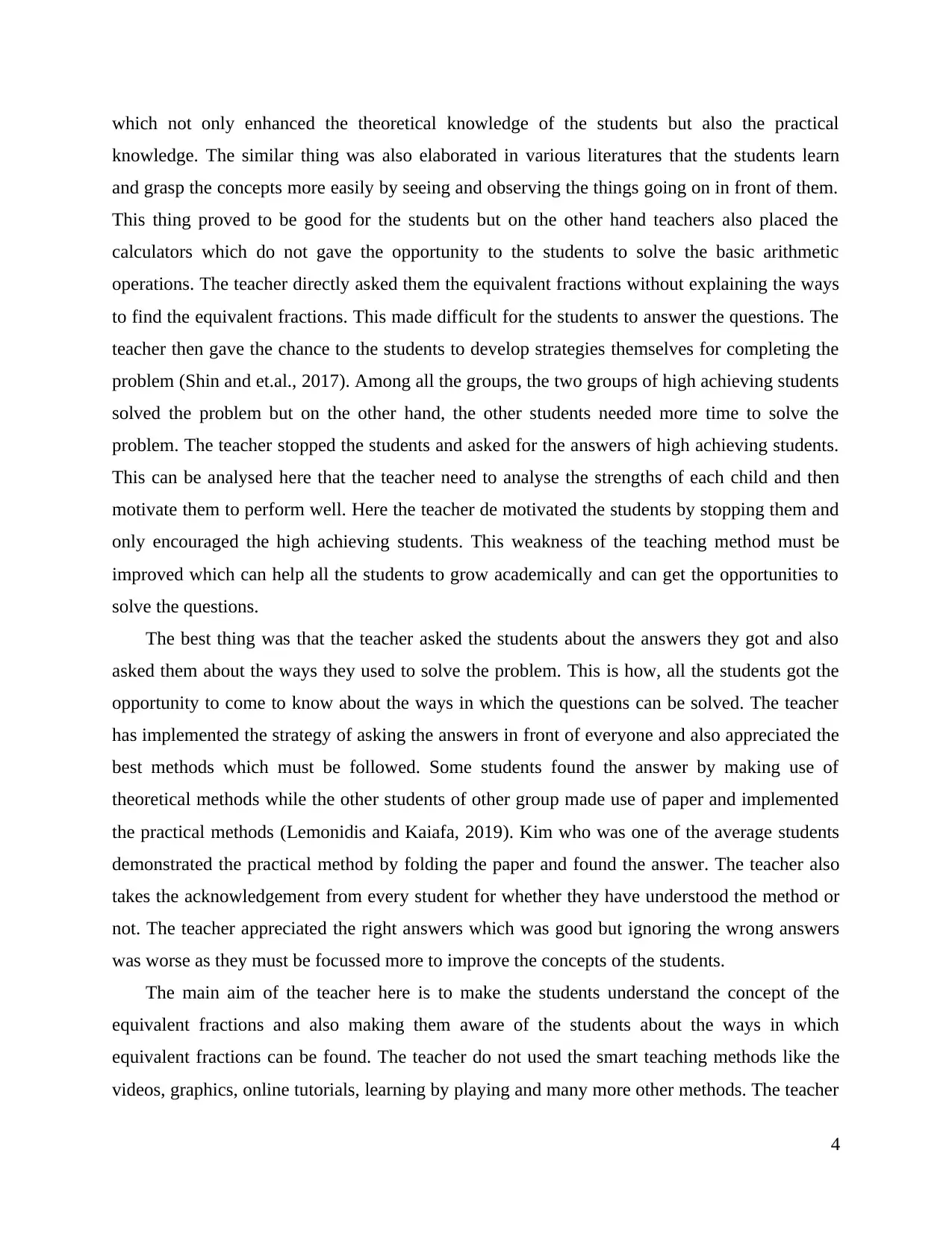
which not only enhanced the theoretical knowledge of the students but also the practical
knowledge. The similar thing was also elaborated in various literatures that the students learn
and grasp the concepts more easily by seeing and observing the things going on in front of them.
This thing proved to be good for the students but on the other hand teachers also placed the
calculators which do not gave the opportunity to the students to solve the basic arithmetic
operations. The teacher directly asked them the equivalent fractions without explaining the ways
to find the equivalent fractions. This made difficult for the students to answer the questions. The
teacher then gave the chance to the students to develop strategies themselves for completing the
problem (Shin and et.al., 2017). Among all the groups, the two groups of high achieving students
solved the problem but on the other hand, the other students needed more time to solve the
problem. The teacher stopped the students and asked for the answers of high achieving students.
This can be analysed here that the teacher need to analyse the strengths of each child and then
motivate them to perform well. Here the teacher de motivated the students by stopping them and
only encouraged the high achieving students. This weakness of the teaching method must be
improved which can help all the students to grow academically and can get the opportunities to
solve the questions.
The best thing was that the teacher asked the students about the answers they got and also
asked them about the ways they used to solve the problem. This is how, all the students got the
opportunity to come to know about the ways in which the questions can be solved. The teacher
has implemented the strategy of asking the answers in front of everyone and also appreciated the
best methods which must be followed. Some students found the answer by making use of
theoretical methods while the other students of other group made use of paper and implemented
the practical methods (Lemonidis and Kaiafa, 2019). Kim who was one of the average students
demonstrated the practical method by folding the paper and found the answer. The teacher also
takes the acknowledgement from every student for whether they have understood the method or
not. The teacher appreciated the right answers which was good but ignoring the wrong answers
was worse as they must be focussed more to improve the concepts of the students.
The main aim of the teacher here is to make the students understand the concept of the
equivalent fractions and also making them aware of the students about the ways in which
equivalent fractions can be found. The teacher do not used the smart teaching methods like the
videos, graphics, online tutorials, learning by playing and many more other methods. The teacher
4
knowledge. The similar thing was also elaborated in various literatures that the students learn
and grasp the concepts more easily by seeing and observing the things going on in front of them.
This thing proved to be good for the students but on the other hand teachers also placed the
calculators which do not gave the opportunity to the students to solve the basic arithmetic
operations. The teacher directly asked them the equivalent fractions without explaining the ways
to find the equivalent fractions. This made difficult for the students to answer the questions. The
teacher then gave the chance to the students to develop strategies themselves for completing the
problem (Shin and et.al., 2017). Among all the groups, the two groups of high achieving students
solved the problem but on the other hand, the other students needed more time to solve the
problem. The teacher stopped the students and asked for the answers of high achieving students.
This can be analysed here that the teacher need to analyse the strengths of each child and then
motivate them to perform well. Here the teacher de motivated the students by stopping them and
only encouraged the high achieving students. This weakness of the teaching method must be
improved which can help all the students to grow academically and can get the opportunities to
solve the questions.
The best thing was that the teacher asked the students about the answers they got and also
asked them about the ways they used to solve the problem. This is how, all the students got the
opportunity to come to know about the ways in which the questions can be solved. The teacher
has implemented the strategy of asking the answers in front of everyone and also appreciated the
best methods which must be followed. Some students found the answer by making use of
theoretical methods while the other students of other group made use of paper and implemented
the practical methods (Lemonidis and Kaiafa, 2019). Kim who was one of the average students
demonstrated the practical method by folding the paper and found the answer. The teacher also
takes the acknowledgement from every student for whether they have understood the method or
not. The teacher appreciated the right answers which was good but ignoring the wrong answers
was worse as they must be focussed more to improve the concepts of the students.
The main aim of the teacher here is to make the students understand the concept of the
equivalent fractions and also making them aware of the students about the ways in which
equivalent fractions can be found. The teacher do not used the smart teaching methods like the
videos, graphics, online tutorials, learning by playing and many more other methods. The teacher
4
Paraphrase This Document
Need a fresh take? Get an instant paraphrase of this document with our AI Paraphraser
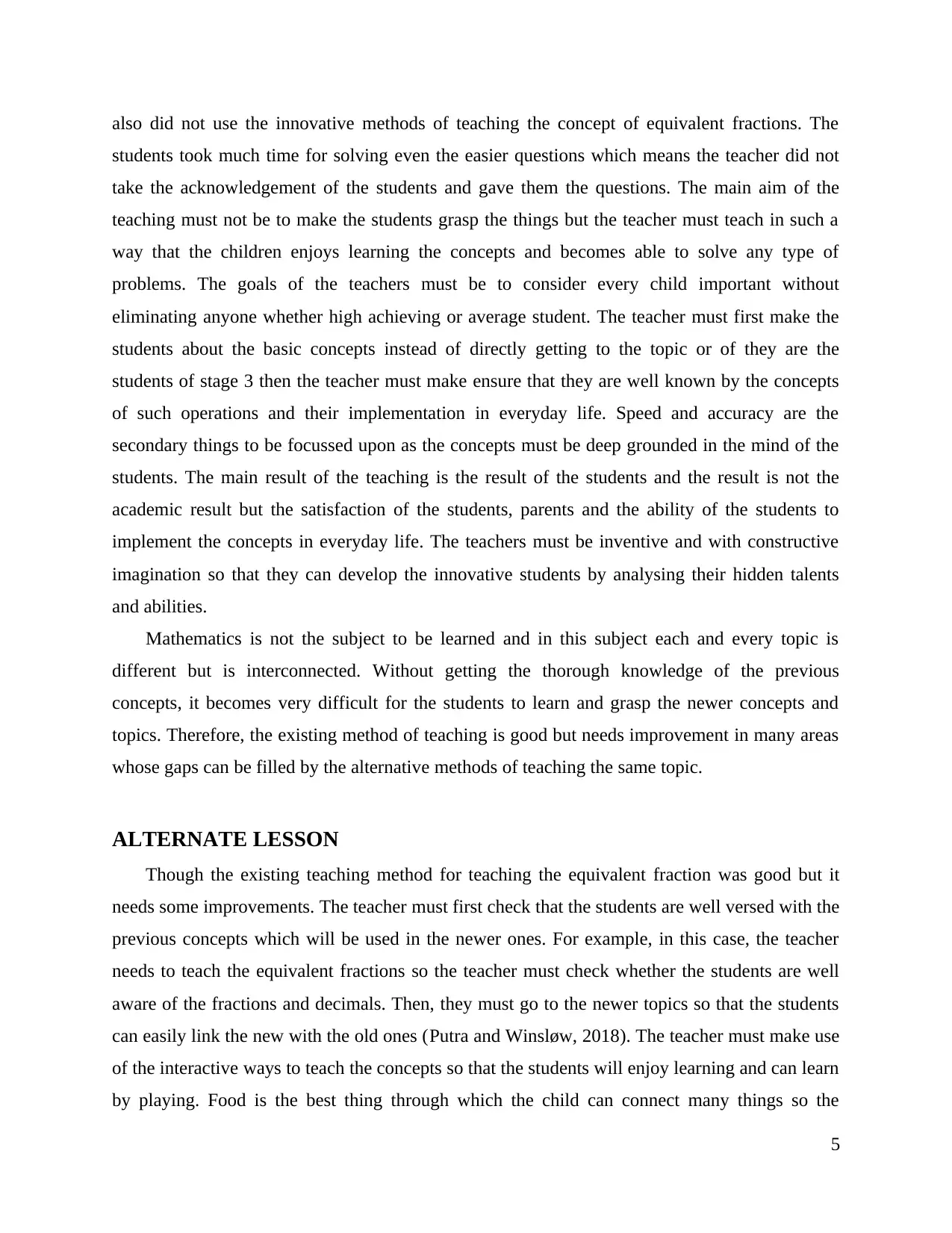
also did not use the innovative methods of teaching the concept of equivalent fractions. The
students took much time for solving even the easier questions which means the teacher did not
take the acknowledgement of the students and gave them the questions. The main aim of the
teaching must not be to make the students grasp the things but the teacher must teach in such a
way that the children enjoys learning the concepts and becomes able to solve any type of
problems. The goals of the teachers must be to consider every child important without
eliminating anyone whether high achieving or average student. The teacher must first make the
students about the basic concepts instead of directly getting to the topic or of they are the
students of stage 3 then the teacher must make ensure that they are well known by the concepts
of such operations and their implementation in everyday life. Speed and accuracy are the
secondary things to be focussed upon as the concepts must be deep grounded in the mind of the
students. The main result of the teaching is the result of the students and the result is not the
academic result but the satisfaction of the students, parents and the ability of the students to
implement the concepts in everyday life. The teachers must be inventive and with constructive
imagination so that they can develop the innovative students by analysing their hidden talents
and abilities.
Mathematics is not the subject to be learned and in this subject each and every topic is
different but is interconnected. Without getting the thorough knowledge of the previous
concepts, it becomes very difficult for the students to learn and grasp the newer concepts and
topics. Therefore, the existing method of teaching is good but needs improvement in many areas
whose gaps can be filled by the alternative methods of teaching the same topic.
ALTERNATE LESSON
Though the existing teaching method for teaching the equivalent fraction was good but it
needs some improvements. The teacher must first check that the students are well versed with the
previous concepts which will be used in the newer ones. For example, in this case, the teacher
needs to teach the equivalent fractions so the teacher must check whether the students are well
aware of the fractions and decimals. Then, they must go to the newer topics so that the students
can easily link the new with the old ones (Putra and Winsløw, 2018). The teacher must make use
of the interactive ways to teach the concepts so that the students will enjoy learning and can learn
by playing. Food is the best thing through which the child can connect many things so the
5
students took much time for solving even the easier questions which means the teacher did not
take the acknowledgement of the students and gave them the questions. The main aim of the
teaching must not be to make the students grasp the things but the teacher must teach in such a
way that the children enjoys learning the concepts and becomes able to solve any type of
problems. The goals of the teachers must be to consider every child important without
eliminating anyone whether high achieving or average student. The teacher must first make the
students about the basic concepts instead of directly getting to the topic or of they are the
students of stage 3 then the teacher must make ensure that they are well known by the concepts
of such operations and their implementation in everyday life. Speed and accuracy are the
secondary things to be focussed upon as the concepts must be deep grounded in the mind of the
students. The main result of the teaching is the result of the students and the result is not the
academic result but the satisfaction of the students, parents and the ability of the students to
implement the concepts in everyday life. The teachers must be inventive and with constructive
imagination so that they can develop the innovative students by analysing their hidden talents
and abilities.
Mathematics is not the subject to be learned and in this subject each and every topic is
different but is interconnected. Without getting the thorough knowledge of the previous
concepts, it becomes very difficult for the students to learn and grasp the newer concepts and
topics. Therefore, the existing method of teaching is good but needs improvement in many areas
whose gaps can be filled by the alternative methods of teaching the same topic.
ALTERNATE LESSON
Though the existing teaching method for teaching the equivalent fraction was good but it
needs some improvements. The teacher must first check that the students are well versed with the
previous concepts which will be used in the newer ones. For example, in this case, the teacher
needs to teach the equivalent fractions so the teacher must check whether the students are well
aware of the fractions and decimals. Then, they must go to the newer topics so that the students
can easily link the new with the old ones (Putra and Winsløw, 2018). The teacher must make use
of the interactive ways to teach the concepts so that the students will enjoy learning and can learn
by playing. Food is the best thing through which the child can connect many things so the
5
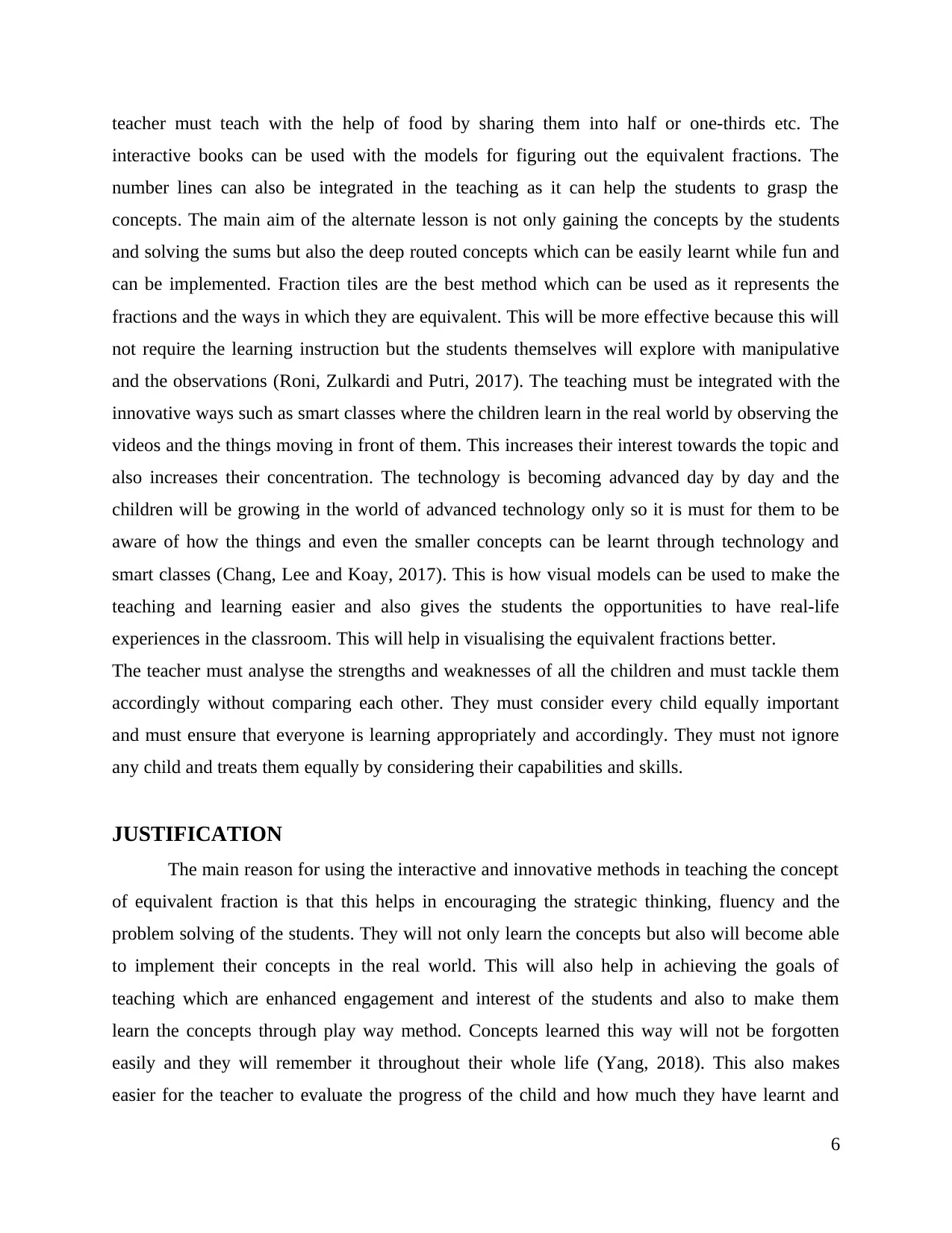
teacher must teach with the help of food by sharing them into half or one-thirds etc. The
interactive books can be used with the models for figuring out the equivalent fractions. The
number lines can also be integrated in the teaching as it can help the students to grasp the
concepts. The main aim of the alternate lesson is not only gaining the concepts by the students
and solving the sums but also the deep routed concepts which can be easily learnt while fun and
can be implemented. Fraction tiles are the best method which can be used as it represents the
fractions and the ways in which they are equivalent. This will be more effective because this will
not require the learning instruction but the students themselves will explore with manipulative
and the observations (Roni, Zulkardi and Putri, 2017). The teaching must be integrated with the
innovative ways such as smart classes where the children learn in the real world by observing the
videos and the things moving in front of them. This increases their interest towards the topic and
also increases their concentration. The technology is becoming advanced day by day and the
children will be growing in the world of advanced technology only so it is must for them to be
aware of how the things and even the smaller concepts can be learnt through technology and
smart classes (Chang, Lee and Koay, 2017). This is how visual models can be used to make the
teaching and learning easier and also gives the students the opportunities to have real-life
experiences in the classroom. This will help in visualising the equivalent fractions better.
The teacher must analyse the strengths and weaknesses of all the children and must tackle them
accordingly without comparing each other. They must consider every child equally important
and must ensure that everyone is learning appropriately and accordingly. They must not ignore
any child and treats them equally by considering their capabilities and skills.
JUSTIFICATION
The main reason for using the interactive and innovative methods in teaching the concept
of equivalent fraction is that this helps in encouraging the strategic thinking, fluency and the
problem solving of the students. They will not only learn the concepts but also will become able
to implement their concepts in the real world. This will also help in achieving the goals of
teaching which are enhanced engagement and interest of the students and also to make them
learn the concepts through play way method. Concepts learned this way will not be forgotten
easily and they will remember it throughout their whole life (Yang, 2018). This also makes
easier for the teacher to evaluate the progress of the child and how much they have learnt and
6
interactive books can be used with the models for figuring out the equivalent fractions. The
number lines can also be integrated in the teaching as it can help the students to grasp the
concepts. The main aim of the alternate lesson is not only gaining the concepts by the students
and solving the sums but also the deep routed concepts which can be easily learnt while fun and
can be implemented. Fraction tiles are the best method which can be used as it represents the
fractions and the ways in which they are equivalent. This will be more effective because this will
not require the learning instruction but the students themselves will explore with manipulative
and the observations (Roni, Zulkardi and Putri, 2017). The teaching must be integrated with the
innovative ways such as smart classes where the children learn in the real world by observing the
videos and the things moving in front of them. This increases their interest towards the topic and
also increases their concentration. The technology is becoming advanced day by day and the
children will be growing in the world of advanced technology only so it is must for them to be
aware of how the things and even the smaller concepts can be learnt through technology and
smart classes (Chang, Lee and Koay, 2017). This is how visual models can be used to make the
teaching and learning easier and also gives the students the opportunities to have real-life
experiences in the classroom. This will help in visualising the equivalent fractions better.
The teacher must analyse the strengths and weaknesses of all the children and must tackle them
accordingly without comparing each other. They must consider every child equally important
and must ensure that everyone is learning appropriately and accordingly. They must not ignore
any child and treats them equally by considering their capabilities and skills.
JUSTIFICATION
The main reason for using the interactive and innovative methods in teaching the concept
of equivalent fraction is that this helps in encouraging the strategic thinking, fluency and the
problem solving of the students. They will not only learn the concepts but also will become able
to implement their concepts in the real world. This will also help in achieving the goals of
teaching which are enhanced engagement and interest of the students and also to make them
learn the concepts through play way method. Concepts learned this way will not be forgotten
easily and they will remember it throughout their whole life (Yang, 2018). This also makes
easier for the teacher to evaluate the progress of the child and how much they have learnt and
6
⊘ This is a preview!⊘
Do you want full access?
Subscribe today to unlock all pages.

Trusted by 1+ million students worldwide
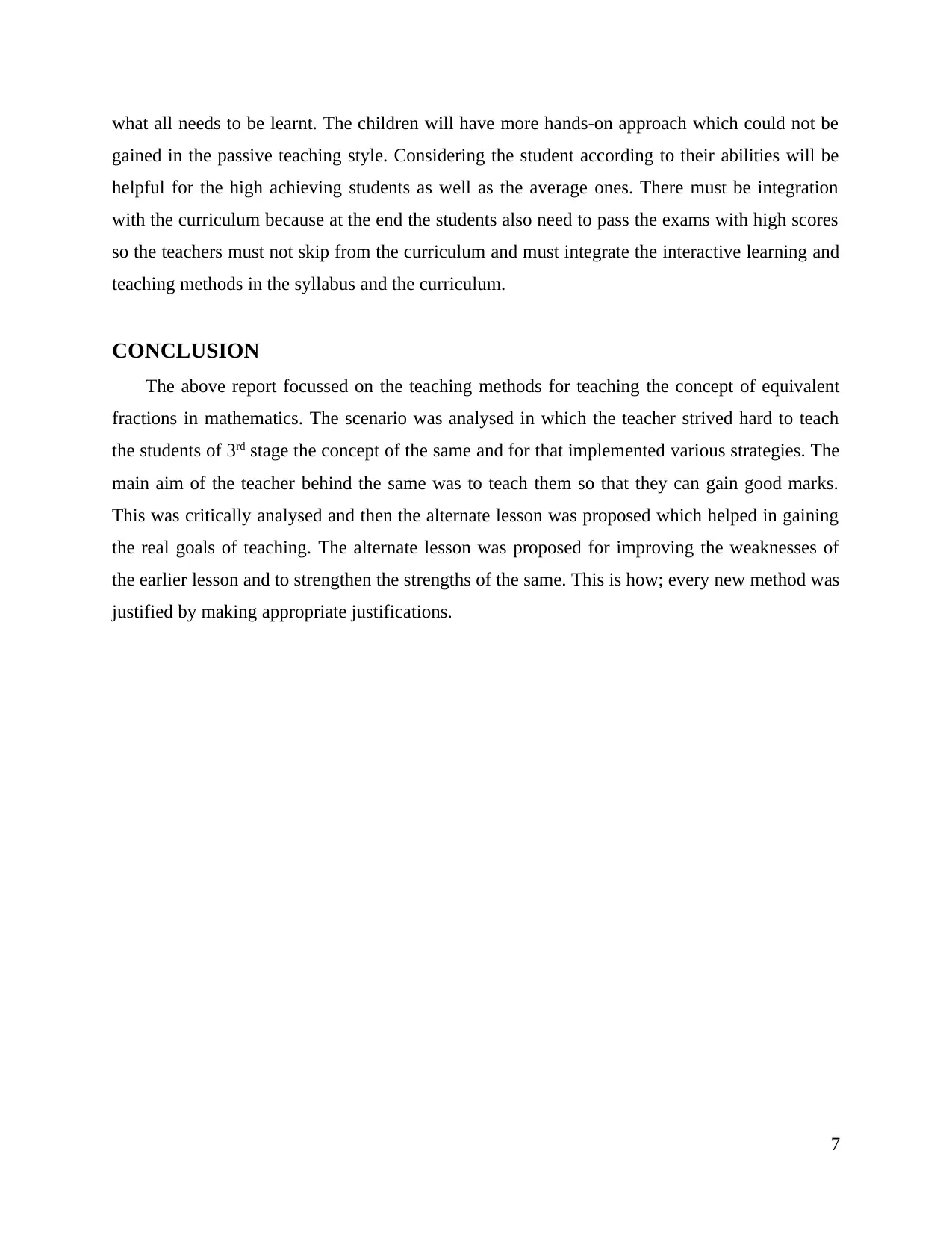
what all needs to be learnt. The children will have more hands-on approach which could not be
gained in the passive teaching style. Considering the student according to their abilities will be
helpful for the high achieving students as well as the average ones. There must be integration
with the curriculum because at the end the students also need to pass the exams with high scores
so the teachers must not skip from the curriculum and must integrate the interactive learning and
teaching methods in the syllabus and the curriculum.
CONCLUSION
The above report focussed on the teaching methods for teaching the concept of equivalent
fractions in mathematics. The scenario was analysed in which the teacher strived hard to teach
the students of 3rd stage the concept of the same and for that implemented various strategies. The
main aim of the teacher behind the same was to teach them so that they can gain good marks.
This was critically analysed and then the alternate lesson was proposed which helped in gaining
the real goals of teaching. The alternate lesson was proposed for improving the weaknesses of
the earlier lesson and to strengthen the strengths of the same. This is how; every new method was
justified by making appropriate justifications.
7
gained in the passive teaching style. Considering the student according to their abilities will be
helpful for the high achieving students as well as the average ones. There must be integration
with the curriculum because at the end the students also need to pass the exams with high scores
so the teachers must not skip from the curriculum and must integrate the interactive learning and
teaching methods in the syllabus and the curriculum.
CONCLUSION
The above report focussed on the teaching methods for teaching the concept of equivalent
fractions in mathematics. The scenario was analysed in which the teacher strived hard to teach
the students of 3rd stage the concept of the same and for that implemented various strategies. The
main aim of the teacher behind the same was to teach them so that they can gain good marks.
This was critically analysed and then the alternate lesson was proposed which helped in gaining
the real goals of teaching. The alternate lesson was proposed for improving the weaknesses of
the earlier lesson and to strengthen the strengths of the same. This is how; every new method was
justified by making appropriate justifications.
7
Paraphrase This Document
Need a fresh take? Get an instant paraphrase of this document with our AI Paraphraser
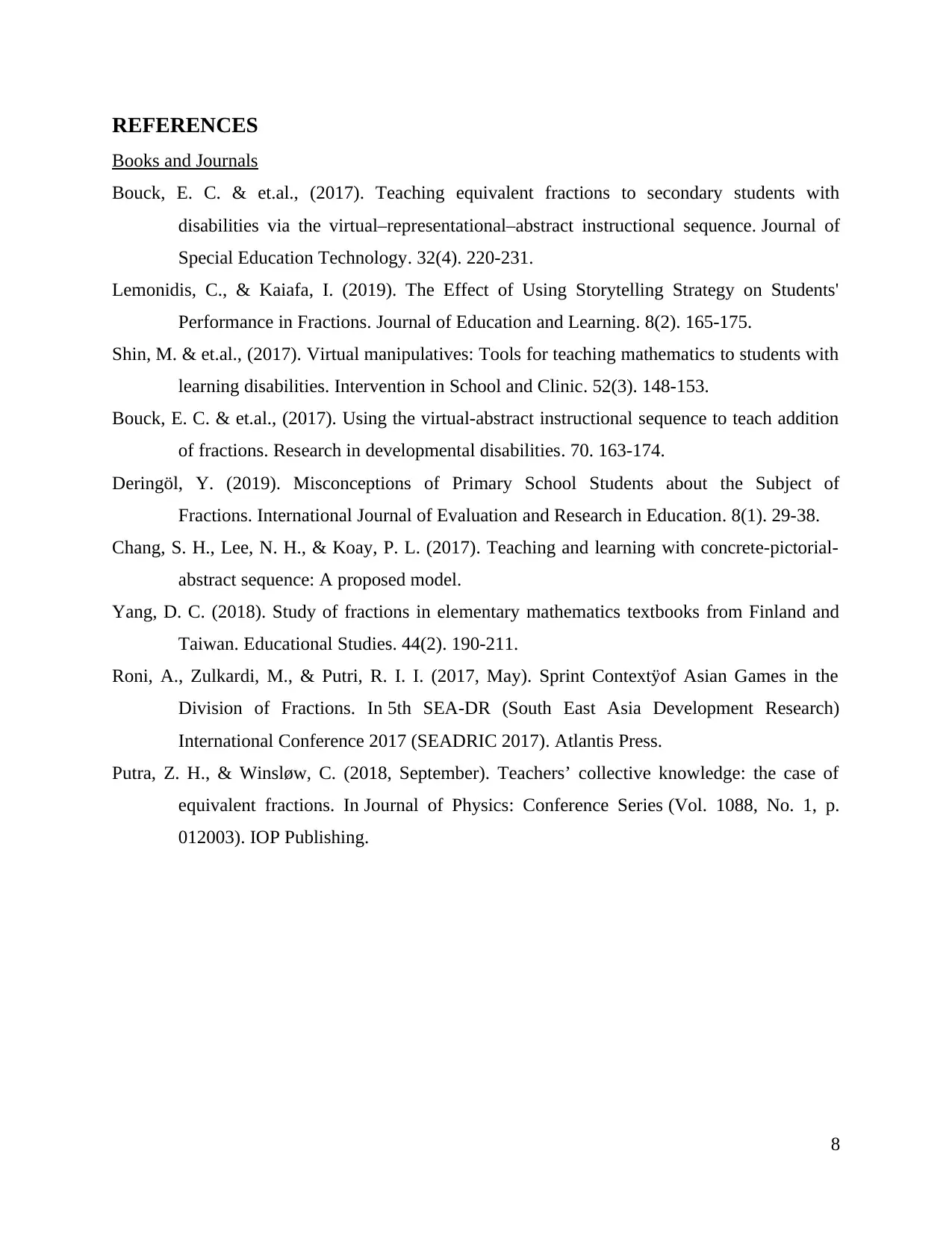
REFERENCES
Books and Journals
Bouck, E. C. & et.al., (2017). Teaching equivalent fractions to secondary students with
disabilities via the virtual–representational–abstract instructional sequence. Journal of
Special Education Technology. 32(4). 220-231.
Lemonidis, C., & Kaiafa, I. (2019). The Effect of Using Storytelling Strategy on Students'
Performance in Fractions. Journal of Education and Learning. 8(2). 165-175.
Shin, M. & et.al., (2017). Virtual manipulatives: Tools for teaching mathematics to students with
learning disabilities. Intervention in School and Clinic. 52(3). 148-153.
Bouck, E. C. & et.al., (2017). Using the virtual-abstract instructional sequence to teach addition
of fractions. Research in developmental disabilities. 70. 163-174.
Deringöl, Y. (2019). Misconceptions of Primary School Students about the Subject of
Fractions. International Journal of Evaluation and Research in Education. 8(1). 29-38.
Chang, S. H., Lee, N. H., & Koay, P. L. (2017). Teaching and learning with concrete-pictorial-
abstract sequence: A proposed model.
Yang, D. C. (2018). Study of fractions in elementary mathematics textbooks from Finland and
Taiwan. Educational Studies. 44(2). 190-211.
Roni, A., Zulkardi, M., & Putri, R. I. I. (2017, May). Sprint Contextÿof Asian Games in the
Division of Fractions. In 5th SEA-DR (South East Asia Development Research)
International Conference 2017 (SEADRIC 2017). Atlantis Press.
Putra, Z. H., & Winsløw, C. (2018, September). Teachers’ collective knowledge: the case of
equivalent fractions. In Journal of Physics: Conference Series (Vol. 1088, No. 1, p.
012003). IOP Publishing.
8
Books and Journals
Bouck, E. C. & et.al., (2017). Teaching equivalent fractions to secondary students with
disabilities via the virtual–representational–abstract instructional sequence. Journal of
Special Education Technology. 32(4). 220-231.
Lemonidis, C., & Kaiafa, I. (2019). The Effect of Using Storytelling Strategy on Students'
Performance in Fractions. Journal of Education and Learning. 8(2). 165-175.
Shin, M. & et.al., (2017). Virtual manipulatives: Tools for teaching mathematics to students with
learning disabilities. Intervention in School and Clinic. 52(3). 148-153.
Bouck, E. C. & et.al., (2017). Using the virtual-abstract instructional sequence to teach addition
of fractions. Research in developmental disabilities. 70. 163-174.
Deringöl, Y. (2019). Misconceptions of Primary School Students about the Subject of
Fractions. International Journal of Evaluation and Research in Education. 8(1). 29-38.
Chang, S. H., Lee, N. H., & Koay, P. L. (2017). Teaching and learning with concrete-pictorial-
abstract sequence: A proposed model.
Yang, D. C. (2018). Study of fractions in elementary mathematics textbooks from Finland and
Taiwan. Educational Studies. 44(2). 190-211.
Roni, A., Zulkardi, M., & Putri, R. I. I. (2017, May). Sprint Contextÿof Asian Games in the
Division of Fractions. In 5th SEA-DR (South East Asia Development Research)
International Conference 2017 (SEADRIC 2017). Atlantis Press.
Putra, Z. H., & Winsløw, C. (2018, September). Teachers’ collective knowledge: the case of
equivalent fractions. In Journal of Physics: Conference Series (Vol. 1088, No. 1, p.
012003). IOP Publishing.
8
1 out of 8
Related Documents
Your All-in-One AI-Powered Toolkit for Academic Success.
+13062052269
info@desklib.com
Available 24*7 on WhatsApp / Email
![[object Object]](/_next/static/media/star-bottom.7253800d.svg)
Unlock your academic potential
Copyright © 2020–2025 A2Z Services. All Rights Reserved. Developed and managed by ZUCOL.




